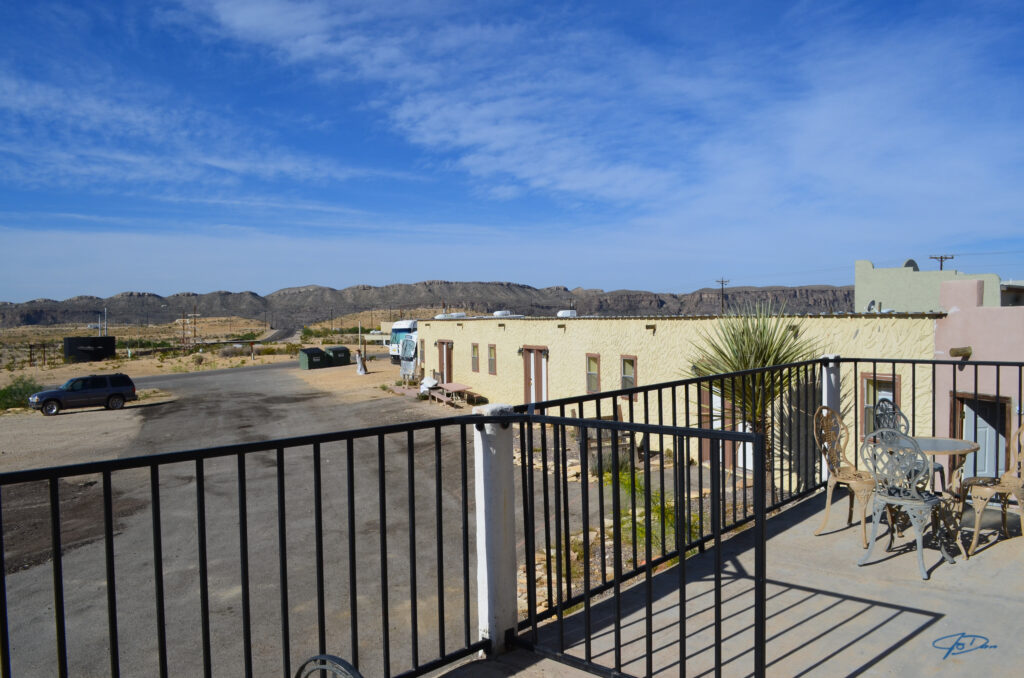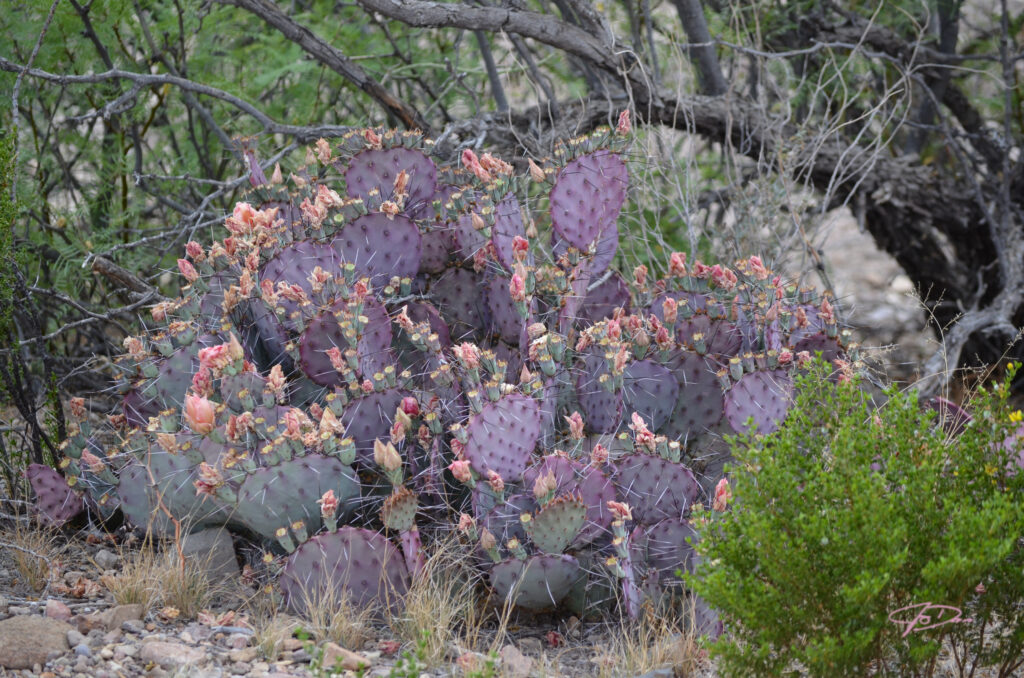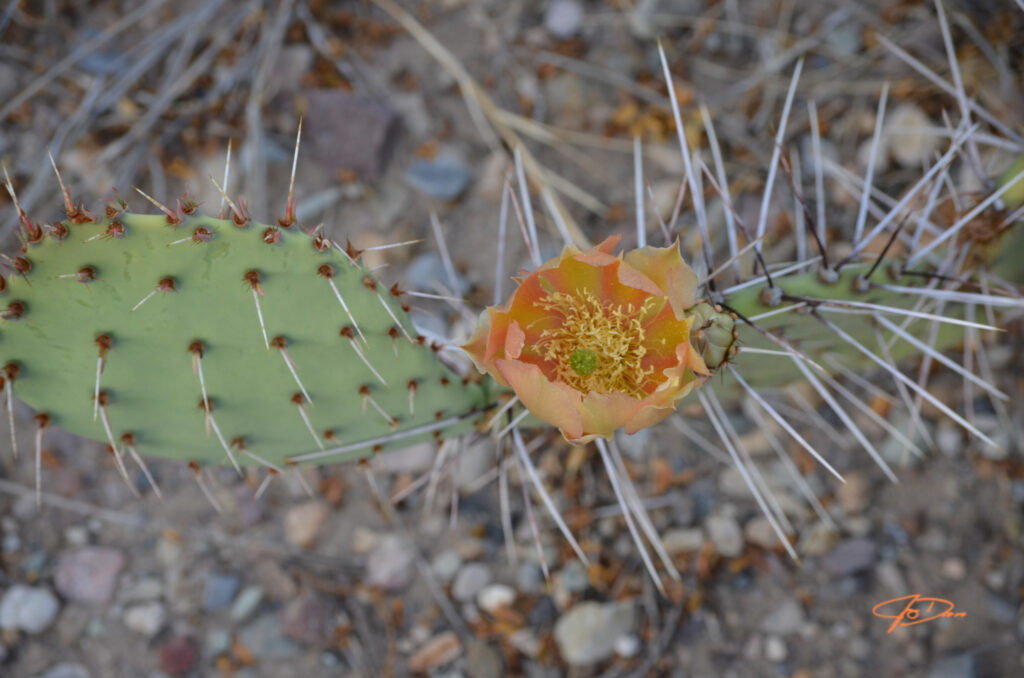Dan and I drove down to Big Bend National Park in Texas from Austin. The first thing we did was take a picture of the sign and me. I had wanted to be comfortable, so I wore something that had nothing binding. Freedom. Knowing perfectly well that I look like an idiot; I’m including the picture. I was excited, and sometimes I act silly when I’m a notch or two above happy. Maybe more than sometimes, but that’s part of who I am, so…

Next, we went to find someplace to live for the next few days. As usual, we didn’t make a reservation, preferring to play it by ear. We found a comfortable room at El Dorado Hotel in Terlingua.

El Dorado Hotel. The actual rooms were beside and slightly behind this building that housed the High Sierra Bar and Grill, and the hotel business office.

The view from our second-floor room patio. To the right, down the road you see in front of us, is the ghost town of old Terlingua, a mining town around the turn of the 20th century.
During each of the next few days, we visited Big Bend National Park. As we walked around, my brain was playing an extended version. Imagine trekking across the hot barren desert, your body blanketed with sweat. An occasional, slight breeze cools and feels like an omen; there’s hope there, like a change is coming and you know it will be for the better. Something good is on the way, any time now. I was feeling it.
I wanted to get a good cactus picture and took several shots. Most of them turned out to be prickly pear. They are native to southwestern Texas and are also the state plant of Texas, and they abound in Big Bend.
It happened that the purple of the one below perfectly matched the purple walls in our bedroom, I had it enlarged and there it hangs.

Prickly Pear – Opuntia genus.
At the time, I knew nothing about the different kinds of Cacti, but, since I look at this picture at least every morning when I wake up, I wanted to know its name. I googled and found it is commonly known as Prickly Pear, a specific species of cactus within the Opuntia genus.
Prickly Pears are characterized by their large flat, paddle-shaped stem pads called cladodes, which grow in various shades of green, green-blue, or purple. They have small white hairlike needles or spines (glochids), which easily detach from the plant. Don’t touch.
The cactus blooms vary. They can be yellow, peach, orange, or even reddish purple.
Another common name, blind prickly pear or cow blinder, comes from the fact that the needles, may be carried away by the wind and can lodge in the skin, stinging on contact, and can blind animals or people should they hit just right.
I happened to know of someone who experienced what I am now calling a Cactus Breeze. She had a few Prickly Pear Cacti on her property. She was near them when a gust of wind came up suddenly and blew through the cactus onto her, blasting her with needles. She tried brushing them off but with no luck.

This close-up shot of another Prickly Pear clearly shows the prickly spines.
She said, “No matter what I did, the needles remained. I froze. I was trapped by the dreadful cactus wind.”
At first, she thought that since the wind blew them on her, it would blow them off, but the oils in her skin were like a magnet. It seemed the harder she tried to get them off the deeper they drilled into her skin.
When a Cactus breeze gets you, it sticks. Eventually, over time, they work themselves out.
To me, the hit of the cactus spines feels like the perfect analogy for loneliness, which also stings and stays with you as long as it wants.
The image of loneliness that I see in my mind is one brought about by a poem written by a friend of mine, Ruth LaPrade (later Ruth Cerny) about a lonely waitress dressed in black and working for years in a small run-down café. Ruth called her the essence of loneliness.
When Dan and I stopped to eat at a little café, I thought of her; I looked for her, but the one waitress there, although alone, seemed quite happy.
The vastness of a desert setting can make you feel either way – lonely, insignificant, and small, or, that you are a part of this huge natural environment. Alone, but one with Mother Nature, in communion with her and with your truest self.
One other thing I learned about Pricky Pears – they are edible and were named for the shape of the fruit that they grow. Maybe that’s a commonly known fact, but, not having known anything about cactus, it was news to me. The flowers turn into pear-shaped fruit called tuna and, I’ve read, taste a bit like watermelon, somewhat sweet, but not overly.
The paddles, also called nopales, are used in dishes as a vegetable and commonly used as a side or main dish in authentic Mexican cuisine.
Both the paddles and the fruit are rich in nutrients. The fruit is often called a superfood. In either case, the needles are a problem and have to be removed. To me, it seems a difficult, intricate, and iffy process that I’m not qualified to discuss. I don’t know what happens if you accidentally ingest the needles, but I don’t want to find out.
Besides the cactus pictures, I also had my heart set on a good mountain sunset. I didn’t get the image I saw in my mind, but to close this off, as if it were an ending of a great day, which it was, here’s a good one.

I’ll leave you with this unsolicited word of advice.
Beware, don’t stand downwind of a Prickly Pear.
Thanks for your interest,
Love,
Jo Wilburn
